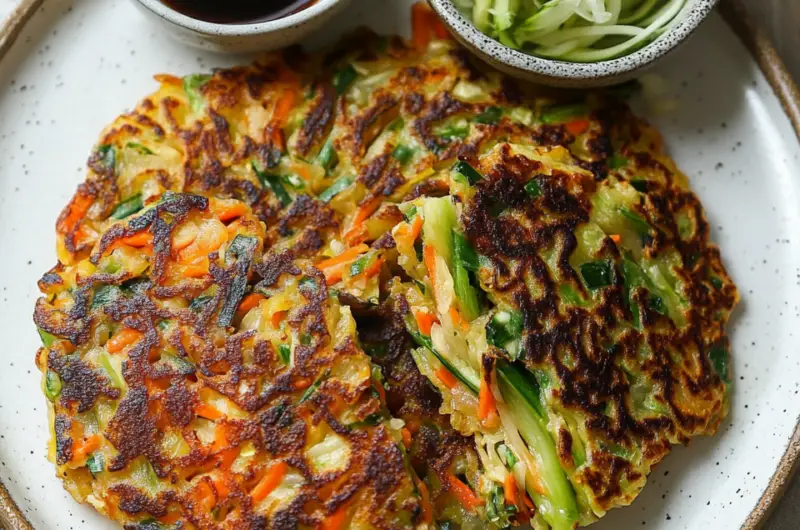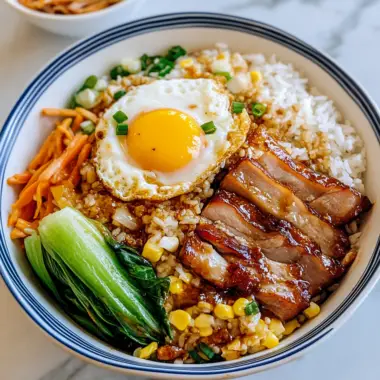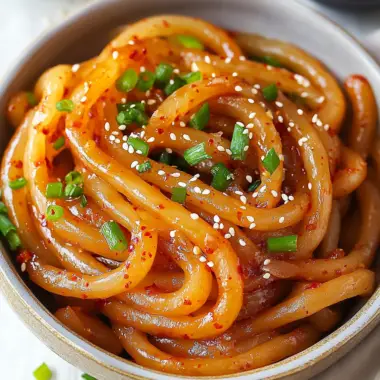Korean Vegetable Pancakes, or Yachaejeon, are a beloved staple in Korean households, offering a savory and crispy snack that perfectly balances comfort and flavor. Made from a light batter and a medley of vegetables like carrots, zucchini, cabbage, and green onions, these pancakes are pan-fried to a golden brown for a crunchy finish. Served with a tangy soy-based dipping sauce, each bite is satisfying and full of umami. These pancakes are ideal for a quick snack, a lunchbox addition, or as part of a Korean-style dinner spread. They’re highly adaptable, too you can use whatever vegetables you have on hand, and even add mushrooms or chili for a deeper flavor. Whether you’re new to Korean cuisine or looking for a fun way to enjoy veggies, Yachaejeon delivers on simplicity and taste.
Full Recipe:
Ingredients:
-
1 cup all-purpose flour
-
2 tbsp cornstarch
-
1 tsp salt
-
1/2 tsp ground black pepper
-
1/2 tsp garlic powder
-
3/4 cup cold water (adjust as needed)
-
1/2 cup julienned carrots
-
1/2 cup julienned zucchini
-
1/2 cup thinly sliced green onions
-
1/2 cup shredded cabbage
-
Neutral oil for frying
Dipping Sauce:
-
2 tbsp soy sauce
-
1 tbsp rice vinegar
-
1 tsp sesame oil
-
1/2 tsp sugar
-
1/2 tsp red pepper flakes (optional)
-
1/2 tsp toasted sesame seeds
Directions:
-
In a bowl, mix flour, cornstarch, salt, pepper, and garlic powder. Gradually add cold water and whisk until smooth.
-
Add all vegetables to the batter and gently fold to combine.
-
Heat a non-stick skillet over medium-high heat and add a tablespoon of oil.
-
Spoon the batter into the pan and spread it out evenly into a thin layer.
-
Fry for 3-4 minutes on each side until golden brown and crispy.
-
Transfer to a paper towel to absorb excess oil. Repeat with remaining batter.
-
Mix all dipping sauce ingredients in a small bowl.
-
Slice the pancakes into wedges and serve warm with dipping sauce.
Prep Time: 10 minutes | Cooking Time: 15 minutes | Total Time: 25 minutes
Kcal: 220 kcal | Servings: 2-3 servings
Korean Vegetable Pancakes
Korean Vegetable Pancakes, known as Yachaejeon in Korean, are a popular comfort food dish cherished for their crisp texture, vibrant vegetables, and simplicity. Made with a mixture of flour, water, and assorted vegetables, these pancakes are pan-fried until golden brown and served with a savory dipping sauce, typically made with soy sauce, vinegar, and sesame oil. Yachaejeon can be found everywhere in Korea from street stalls and traditional homes to upscale restaurants.
They are a great way to enjoy seasonal produce, making them both economical and nutritious. Because of their flexibility and ease of preparation, Korean vegetable pancakes have gained global popularity and are now appreciated across various cultures and dietary lifestyles.
The Cultural Significance of Yachaejeon
In Korean cuisine, jeon refers broadly to anything pan-fried in a batter or egg wash. There are many varieties, such as haemul pajeon (seafood scallion pancakes) and kimchi jeon (kimchi pancakes), but yachaejeon literally meaning “vegetable jeon” remains a classic vegetarian choice.
Yachaejeon is often served during traditional holidays like Chuseok (Korean Thanksgiving) or family gatherings, where a variety of jeon dishes are made and enjoyed together. However, these pancakes are also a beloved part of everyday meals and are especially popular on rainy days. There’s even a cultural saying in Korea: “It’s a jeon kind of day,” implying that the gray, cozy weather calls for the sizzling comfort of pancakes.
This tradition is deeply rooted in the sensory pleasure of hearing pancakes frying in oil, evoking warmth, nostalgia, and a sense of home.
Why Korean Vegetable Pancakes Are So Popular
There are several reasons why Yachaejeon stands out in Korean cuisine and appeals to home cooks worldwide:
-
Simplicity and Speed – The recipe requires only basic pantry ingredients and minimal preparation. It takes less than 30 minutes from start to finish, making it an ideal weeknight meal or quick snack.
-
Customizable – You can use almost any vegetables you have on hand. Carrots, green onions, zucchini, mushrooms, bell peppers, and even leftover cabbage all work beautifully.
-
Diet-Friendly – Yachaejeon is naturally vegetarian, and it can easily be made vegan by ensuring the dipping sauce and batter don’t contain any animal-based ingredients. For those on gluten-free diets, simple substitutions like rice flour or gluten-free flour blends can be used.
-
Crispy Texture – The exterior is crunchy while the inside remains soft and flavorful thanks to the moisture from the vegetables. The contrast is satisfying and makes it incredibly addictive.
-
Perfect for Sharing – These pancakes are often sliced into wedges and shared communally, making them perfect for gatherings, potlucks, or family meals.
Flavor Profile and Pairings
The flavor of Yachaejeon is mildly savory with natural sweetness from the vegetables. The batter itself is lightly seasoned, allowing the freshness of the ingredients to shine. The true flavor burst comes from the dipping sauce a tangy, salty, slightly spicy blend of soy sauce, vinegar, sugar, and sesame oil that enhances every bite.
For pairings, these pancakes are best served warm, alongside a bowl of steamed rice and other Korean banchan (side dishes) like kimchi, pickled radish, or seasoned spinach. For beverages, many Koreans enjoy pairing jeon with makgeolli, a slightly sweet Korean rice wine, especially during rainy weather.
Health Benefits and Nutritional Value
Yachaejeon isn’t just delicious it also packs in a good dose of vegetables, which makes it a great way to include more plant-based nutrients in your diet. The dish is low in sugar and can be controlled in fat content depending on the amount and type of oil used for frying.
Here are some nutritional highlights:
-
Fiber – From cabbage, carrots, and other vegetables, aiding digestion.
-
Vitamin C & A – Carrots and zucchini are rich in essential vitamins for immune support and eye health.
-
Low-Calorie – A small serving provides a fulfilling meal or snack without being overly caloric.
To make them even healthier, you can pan-fry with avocado oil or use an air fryer for a lower-fat version.
Tips for Perfect Korean Vegetable Pancakes
Even though the dish is simple, a few tips can help you get the perfect texture and taste:
Advertisement
-
Thin Slicing – Slice all vegetables into thin, uniform strips. This ensures even cooking and helps everything bind together.
-
Cold Water Batter – Using cold water can help the batter stay crispier when frying.
-
Don’t Overcrowd the Pan – Cook in batches if necessary to maintain crispiness. Overcrowding will result in steaming, not frying.
-
Press Gently – While cooking, press down the pancake lightly with a spatula to ensure an even, crispy crust.
Variations You Can Try
If you’re feeling creative or have specific dietary needs, Yachaejeon offers endless variations. Here are a few:
-
Kimchi Yachaejeon – Add chopped kimchi for tang and spice.
-
Mushroom Jeon – Include shiitake or oyster mushrooms for an umami boost.
-
Seaweed Flakes – A sprinkle of gim (roasted seaweed) adds oceanic flavor.
-
Spicy Version – Add sliced chilies or gochugaru (Korean red pepper flakes) to the batter for heat.
-
Cheese Fusion – Though not traditional, some modern recipes add shredded cheese for a Korean-Western twist.
Conclusion:
Korean Vegetable Pancakes (Yachaejeon) are a testament to the beauty of simple cooking. They bring together the earthy sweetness of fresh vegetables, the crisp satisfaction of pan-fried batter, and the savory depth of a soy-based dipping sauce. Whether you’re new to Korean cuisine or a long-time fan, this dish provides an easy entry point into traditional Korean flavors.
Its versatility, affordability, and comforting nature make Yachaejeon an essential recipe in any home cook’s repertoire. You can serve it as a quick lunch, a snack, a dinner side dish, or even as part of a celebratory spread. However you enjoy it, it’s sure to bring joy, crisp bites, and a little piece of Korean food culture to your table.








